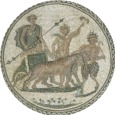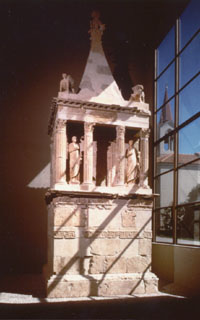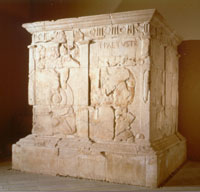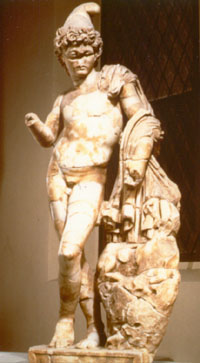Ministero per i Beni |
 |
Soprintendenza
per i Beni Archeologici |
Ministero per i Beni |
 |
Soprintendenza
per i Beni Archeologici |
|
Home |
National Archeological Museum
| Address | Via Cesio Sabino, n. 39 - 47027 SARSINA (FC) | |
| Phone | +39 0547 94641 | |
|
Opening hours closed on monday |
From Tuesday to Sunday, inclused holiday, following opening hours: - From 1st October to 31st May: 8,30 a.m. - 1,30 p.m. - From 1st June to 30th September: 1,30 p.m. - 6,30 p.m. |
|
| Closed on following holidays: 1st May, Christmas, New Year's day | ||
| Ticket | Adults
(from 25 to 65 years): € 2,00 Reduced price (from 18 to 25 years): € 1,00 Younger than 18 years and older than 65 years: free |
|
| Director | Dott.ssa Chiara Guarnieri | |
| Further information | Soprintendenza
per i Beni Archeologici dell'Emilia Romagna Via Belle Arti, 52 40126 BOLOGNA http://www.archeobo.arti.beniculturali.it E-mail: archeobo@arti.beniculturali.it Tel. +39 051 223773 / 220675 / 224402 Fax +39 051 227170 |
|
| Virtual visit in the museum | The
rooms of the Museum Ground floor First floor 2° nd floor |
|
| The didactic guide | The
history of the ancien Sarsina The findings in the city The archaeological museum The excavation in Pian di Bezzo The topography of the necropolis |
The
typologies of the sepulchres The roman burial rites The oriental divinities The city walls |
 The Mausoleum di Rufus (Ministero per i Beni e le Attività Culturali - Museo Archeologico Nazionale Sarsinate) |
It is one of the most important archeological museums of the North
Italy,
thanks to its richness and variety of remains it contains. The institute was founded in 1890 as municipal collection by Antonio Santarelli, a Forlì archeologist who was entrusted by the town council to collect and arrange various antiquities of local provenance and roman inscriptions. The main core of the display is described by canon Filippo Antonini, an erudite humanist from Sarsina , in his book "Le antichità di Sarsina" (Sarsina antiquities), published in 1607. A notable growth in the collections took place as a result of the excavations promoted in the area of the Roman necropolis located to the south of the city at Pian di Bezzo. Thanks to these excavations, a lot of funerary monuments were found and the museum was further enlarged by the numerous finds coming from the centre of the city, which were added to the collections. After 1957, the acquisition of the museum by the State led to radical transformations and it was completely rearranged. In the Eighties thanks to the cooperation of the Municipality of Sarsina, the Soprintendenza Archeologica of Bologna encreased the rooms for the exposition; the restoration of some of the main monuments of the necropolis, previously dismembered, are one of the highlights of the new display. The collections of the museum, which are mostly of local provenance, even if they belong to a period which goes from the prehistory to the late antiquity, concern particularly the roman age. In the exposition itinerary, which mainly consists of epigraphs and funerary markers, the rooms of the ground floor now house the lapidary, providing a panorama of the ancient Sassina social life, through the names of the most important local families. Among these, one of the most interesting is the funerary monument of Cetrania Severina (first half of the 2nd century a.C.), which shows, on a side, a part of her will in favour of the collegia ( professional guilds), of the dendrophori , fabri and centonari , who received a legacy to destine every year to ritual offers, in order to pay honour to the dead’s memory. The sepulchral prescription of Horatius Balbus (1st century b.C.) is also very important: its text reminds of the offering of a piece of ground in the neighbourhood of the necropolis, to use for the burial of people in need ,excepting those who were considered unworthy. Another two interesting funerary artifacts, coming from the necropolis of Pian di Bezzo, are those of Publius Verginius Paetus and Rufus. The latter is one of the greatest attactions of the museum. Besides, you can find other stelae, and among them there is also the one once delimiting the sepulchral area of the muliones’ guild. Among the remains coming from the urban area, there is the large polychrome mosaic with the triumph of Dionysus – Baccus, called "Trionfo di Dioniso" . The witnesses of various cults, linked to the greek world ( Giove, Minerva, Apollo), to the roman – italic tradition (Spes, Dei Publici), up to the oriental world, are of exceptional interest. In fact, you can find, inside the museum, the sculptural cycle of egyptian and oriental divinities, which represented the most important sanctuary dedicated to these cults, in the North Italy. Among these, the most valuable statue is the one of the young Attis. Among the honorary inscriptions, some remind of members of the imperial family ( Nerva, Traiano, Faustina Maggiore, Marco Aurelio), and important local people (L. Appaeus Pudens, Aulus Pudens, C. Caesius Sabinus, S. Montanus ); the civic inscriptions remind of the construction of the defensive town – walls (70 – 40 b. C.), and in particular the magistrates who promoted the carrying out of the town – walls (quattuorviri iure dicundo), an architectus who took care of its construction, and the differents parts of the work (murus, valvae, portae, turres). On the upper floor there are the naturalistic and prehistoric collections, material from the Umbrian pre-Roman settlement (IV-II century b.C.), and also rocks, minerals and fossils coming from the Savio valley, household goods such as late Imperial refectory glass and glazed and relief decorated ceramics; grave goods from tombs (with the reconstruction of a "cappuccina" burial); various building materials and sections of floor in opus signinum (decorated earthenware), lead pipes. Besides, you can find glasses, materials coming from the ancient thermae in Bagno di Romagna, various marble sculptures (portraits of Livia - ? – and of an old man of Republican age), and also a mosaic representing Ercole and marine depictions, which was the floor of a small triclinium of a domus. Of this domus it has been also found pieces of plaster, many pots and a game. In this site, we show four of the most important remains that are kept in the museum. |
|
 The Monument of Publius Virginius Paetus (Ministero per i Beni e le Attività Culturali - Museo Archeologico Nazionale Sarsinate) |
||
 Attis (Ministero per i Beni e le Attività Culturali - Museo Archeologico Nazionale Sarsinate) |
||
The reproduction of the pictures on this site for publications is forbidden |
![]()
Latest updating date 20-11-2006